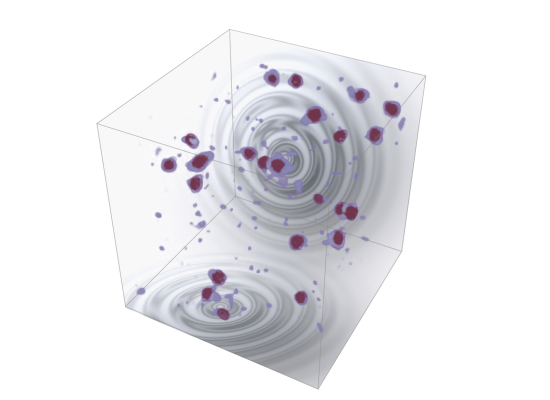11 May, 2023
Kavli Institute for the Physics and Mathematics of the Universe (Kavli IPMU)

Researchers have discovered a new generic production mechanism of gravitational waves generated by a phenomenon known as oscillons, which can originate in many cosmological theories from the fragmentation into solitonic “lumps” of the inflaton field that drove the early Universe’s rapid expansion, reports a new study published in Physical Review Letters.
The results have set the stage for revealing exciting novel insights about the Universe's earliest moments.
The inflationary period, which occurred just after the Big Bang, is believed to have caused the Universe to expand exponentially. In many cosmological theories, the rapid expansion period is followed by the formation of oscillons. Oscillons are a type of localized non-linear massive structure that can form from fields, such as the inflaton field, which are oscillating at high frequencies. These structures can persist for long periods, and as the researchers found, their eventual decay can generate a significant amount of gravitational waves, which are ripples in space-time.
In their study, Kavli Institute for the Physics and Mathematics of the Universe (Kavli IPMU) Project Researcher Kaloian D. Lozanov, and Kavli IPMU Visiting Associate Scientist, International Center for Quantum-field Measurement Systems for Studies of the Universe and Particles (QUP) Senior Scientist, and High Energy Accelerator Research Organization (KEK) Theory Center Assistant Professor Volodymyr Takhistov, simulated the evolution of the inflaton field during the early Universe and found that oscillons were indeed present. They then found that oscillon decay was able to generate gravitational waves that would be detectable by upcoming gravitational wave observatories.
The findings provide a novel test of the early Universe dynamics independent of the conventionally studied cosmic microwave background radiation. The discovery of these gravitational waves would establish a new window into the Universe's earliest moments, and could help shed light on some of the pressing fundamental questions in cosmology.
With the ongoing development of gravitational wave detectors and supercomputing resources, we can expect to gain even more insights into the Universe's early moments in the coming years. Overall, the new study demonstrates the power of combining theoretical models with advanced computational techniques and observations to uncover new insights into the Universe's evolution.
Details of their study were published in Physical Review Letters on May 2.
Paper details
Journal: Physical Review Letters
Title: Enhanced gravitational waves from inflaton oscillons
Authors: Kaloian D. Lozanov (1,2), Volodymyr Takhistov (3,4,2)
Author affiliations:
1 Illinois Center for Advanced Studies of the Universe and Department of Physics, University of Illinois at Urbana-Champaign, Urbana, Illinois 61801, USA
2 Kavli IPMU (WPI), UTIAS, The University of Tokyo, Kashiwa, Chiba 277-8583, Japan
3 International Center for Quantum-field Measurement Systems for Studies of the Universe and Particles (QUP, WPI), High Energy Accelerator Research Organization (KEK), Oho 1-1, Tsukuba, Ibaraki 305-0801, Japan
4 Theory Center, Institute of Particle and Nuclear Studies (IPNS), 9 High Energy Accelerator Research Organization (KEK), Tsukuba 305-0801, Japan
DOI: 10.1103/PhysRevLett.130.181002
Paper abstract (Physical Review Letters)
Preprint (arXiv.org)
Research contact
Kaloian D. Lozanov
Project Researcher
Kavli Institute for the Physics and Mathematics of the Universe (Kavli IPMU)
The University of Tokyo
E: kaloian.lozanov_at_ipmu.jp
* Please change _at_ to @
Media contact
Motoko Kakubayashi
Press officer
Kavli Institute for the Physics and Mathematics of the Universe (Kavli IPMU)
The University of Tokyo
E: press_at_ipmu.jp
* Please change _at_ to @






